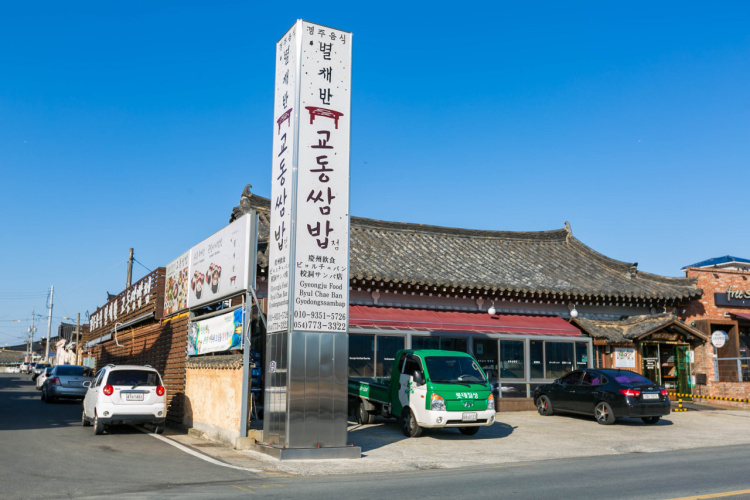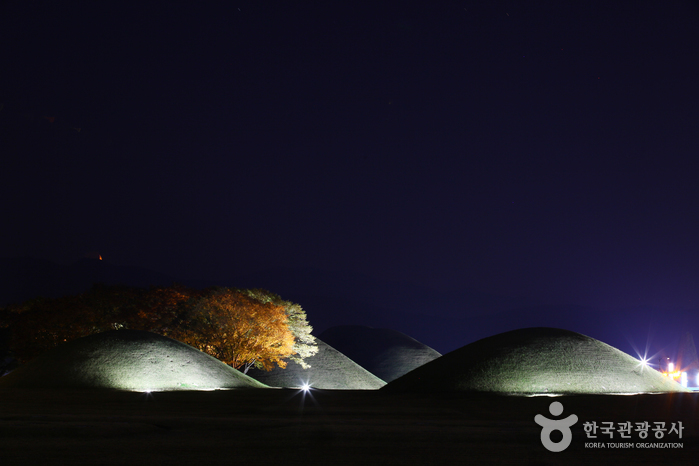Silla Cultural Festival (신라문화제)
1.1 Km 7295 2023-09-14
Gyo-dong, Gyeongju-si, Gyeongsangbuk-do
+82-54-777-5953~4
Silla Cultural Festival is held to promote the excellence of Silla history and culture and to give pride to Gyeongju residents. The festival features a combination of traditional and modern aspects.
Yosokkoong (요석궁)
1.2 Km 53074 2020-07-14
19-4, Gyochonan-gil, Gyeongju-si, Gyeongsangbuk-do
+82-54-772-3347
Named after Silla King Muyeol's daughter, Princess Yoseok, Yosokkoong serves traditional Korean food. The resturant is run by the Choi family, who settled on the site of Princess Yoseok's house during the Joseon dynasty, and has passed on the restaurant and family recipes through 12 generations. All the foods served are made with organic ingredients, for a healthy taste that cannot be found anywhere else.
Byeolchaeban Gyodong Ssambap (별채반 교동쌈밥)
1.2 Km 3 2023-07-12
경상북도 경주시 첨성로 77
Located in Hwangnam-dong, Gyeongju, Byeolchaeban Gyodong Ssambap is a famous joint that has made multiple appearances on TV programs. The signature menu of this restaurant is the leaf wraps and rice, or “ssambap”, where vegetables and leaves are used to create wraps with meat, fish, and other side dishes. The restaurant offers a variety of main dishes for wrapping, such as Pork Bulgogi and Duck Bulgogi. Other dishes include the Yukbuchon Spicy Beef Soup and Gondalbi Bibimbap. This restaurant is also quite appealing for vegan diners, since leaf wraps and rice involve plenty of vegetables. Group seats and reservations are available. Cheomseongdae Observatory and Daereungwon Ancient Tombs are located nearby, making it quite easy to plan the itinerary.
Sihyu Byeoldang [Korea Quality] 시휴별당[한국관광 품질인증]
1.3 Km 0 2023-05-23
15-1, Cheomseong-ro 49beon-gil, Gyeongju-si, Gyeongsangbuk-do
+82-504-0904-2575
Sihyu Byeoldang is a hanok stay near the famous Hwangnidan-gil in Gyeongju, Gyeongsangbuk-do, whose name is made up of hanja characters meaning "time," "separation," "rest," and "home." There are three types of room, spread across a sarangchae, an anchae and an annex. The sarangchae and annex have access to an outdoor swimming pool, while the anchae has an indoor bathtub. We hope the house’s warm atmosphere and the beautiful surrounding scenery will help guests feel truly rested and at home - and perhaps even that time has briefly paused.
Hanokinn [Korea Quality] / 한옥人(한옥인) [한국관광 품질인증/Korea Quality]
1.4 Km 3 2021-03-29
19, Poseok-ro 1050beon-gil, Gyeongju-si, Gyeongsangbuk-do
This hanok (traditional Korean house) is located at the center of Hanok Conservation Area, known as Hwangnidan-gil Street. To the north lies the old alley that connects to Cheomseongdae Observatory. The house has sarangchae building, byeolchae building, and main building, which is used as a gallery and café, surrounding the grass lawn in the center. All rooms are equipped with ondol (under-the-heating system) and a red clay finish, and each room has a bathroom with shower facilities.
Sarangchae is a two-story hanok building with a hipped-and-gable roof. Its first floor is occupied by a double room and a family room, which can support up to 4 people. Byeolchae is a single-floor hanok with a gable roof, containing two double rooms and a raised floor space. The main building’s gallery contains a hanok experience room, cafe, restaurant, and a traditional tea room. A Korean-style breakfast is offered in the cafe, and the management also offers experience programs like tea ceremony, traditional games like yunnori (board game), and traditional musical instruments like janggo (hourglass-shaped drums) and gayageum (twelve-stringed zither).
Gyeongju Royal Tomb of King Naemul (경주 내물왕릉)
1.4 Km 13450 2020-04-04
Gyo-dong, Gyeongju-si, Gyeongsangbuk-do
+82-54-779-6100
King Naemul was the 17th monarch of the Silla Kingdom (in power from 356 to 402) and became the second king of the Kim family name. King Naemul was known as the first king to initiate the king title of ‘Maripgan’ and was known for spreading cultural advancements from China to the Korean people. When the allied forces of Baekje and Japan attacked, he asked Gwanggaeto the Great of Goguryeo for help and led the people to victory, contributing to the increased strength of the Silla Kingdom. After his rule, the throne was exclusively ceded to members of the Kim family clan.
The royal tomb of King Naemul is a large mound (22 m in diameter and 5.3 m in x_height) that sits on the northern hill of the Confucian school of Gyeongju. The edge of a natural stone is exposed around the bottom of the mound, pointing to the fact that the inner chamber tomb was made of stone. In the historical document Samguk Sagi (History of the Three Kingdoms), no records are found about the tomb, but the Samguk Yusa (Memorabilia of the Three Kingdoms) describes the king’s tomb as being located in the southwest of Cheomseongdae, which is consistent with the tomb’s location.
SOSEOLJAE [Korea Quality] / 소설재(첨성대점) [한국관광 품질인증]
1.4 Km 1156 2020-09-09
46, Poseok-ro 1050beon-gil, Gyeongju-si, Gyeongsangbuk-do
+82-54-7357-7412
As a traditional Korean guesthouse with modern facilities but with some traditional features of a Korean house such as wooden floor and ceramic tiled roof intact, Soseoljae is located next to Cheomseongdae in Gyeongju. It also has an old well in the garden. Each guestroom is furnished with bathroom and air conditioner for the convenience of the guests. The single-story guesthouse has a total of 11 rooms that can accommodate 2-4 people depending on the size of the room. The two-story stand-alone guesthouse located right next to the main gate can accommodate six, and it has a small tea room. The guesthouse has a cafe at the entrance. It's conveniently located near Cheomseomdae, Daereungwon Ancient Tombs, and Hwangnyongsaji (Hwangnyongsa Temple Site) as well as Gyeongju Station and Gyeongju Express Bus Terminal.
Gyeongju Gyerim Forest (경주 계림)
1.5 Km 24780 2020-07-06
Gyo-dong, Gyeongju-si, Gyeongsangbuk-do
+82-54-779-8743
Gyerim Forest is located between the Cheomseongdae Observatory and Wolseong Fortress. The forest is thickly populated by ancient zelkova and willow trees rooted on gently sloping hills and along the small stream in the northwest part of the woods. According to legend, the forest is closely associated with myths surrounding the birth of Alji, the founder of the Gyeongju Kim clan. As such, it is designated national Historic Site No. 19.
Legend has it that King Talhae heard a rooster crying from deep inside the Sirim Woods. Chancellor Hogong was sent to investigate. Upon arriving, he found a rooster crying underneath a tree on which hung a golden box. Hogong immediately reported his find to the king, who instructed him to bring the golden box into the palace. The king opened the box and found a small child inside, Kim Alji. The forest, which had previously been called ‘Sirim’ or ‘Gurim’, became known as ‘Gyerim’, ('gye’ meaning rooster). The name Gyerim was also used to refer to the Silla kingdom.
Alji was adopted as the king’s son, but because the crown was passed on to King Pasa of the Park family, he never ascended the throne. The Kim clan later became the royal bloodline with the coronation of King Naemul some years later.
The memorial stone recording the birth of Kim Alji was erected in the third year of King Sunjo's rule in the Joseon dynasty. Located close to the royal fortress of Silla, the forest is still deeply revered as the mystical birthplace of the first ancestor of the royal Kim clan of Silla. Yellow canola blossoms along the path connecting Daereungwon with Gyerim and Banwolseong only add to the magical ambiance of the forest.
Hwangnamguan [Korea Quality] / 주식회사 황남관 [한국관광 품질인증]
1.6 Km 18904 2020-12-16
1038, Poseok-ro, Gyeongju-si, Gyeongsangbuk-do
+82-10-3518-4582
Located in Gyeongju City, Hwangnamgwan is a traditional Korean style accommodation which opened in April 2014. The place looks like a small hanok village with 4 one-story buildings and 2 two-story buildings, constructed on about 5000㎡ of building site. The buildings are equipped with modern convenience facilities but manage to preserve the antique flavor of traditional Korean house. All rooms are equipped with a bathroom. A bathtub is installed in the largest room, Numaru Suite. Auxiliary facilities include the seminar room which is located in the two-story building. There are a cafe and a pizza restaurant on the first floor for meetings or simple meals. Guests are given discount coupons for the cafe.
Various traditional plays can be enjoyed in the hanok. It is possible to take photos with the beautiful Hwangnamgwan building in the background wearing traditional Korean clothes. You can also play Neolttwigi, Tuho, and Jegichagi in the wide yard and experience twisting legs, bastinado, turning the millstone, fulling, Pogurak (dancing play), etc. which have appeared on TV dramas. It is possible to receive discounted services at nearby affiliated facilities: 50% discount at Spalux Jjimjilbang, Kids Cafe, and Sport Town Bowling Center. Famous tourist attractions such as Cheonmachong Tomb, Cheomseongdae Observatory, and Banwolseong Fortress are within walking distance; and the National Gyeongju Museum and Gyeongju World Culture Expo Park are likewise not far from Hwangnamgwan.
Cheomseongdae Observatory (경주 첨성대)
1.6 Km 109092 2023-07-07
140-25, Cheomseong-ro, Gyeongju-si, Gyeongsangbuk-do
+82-54-772-3843
Cheomseongdae Observatory, constructed during the reign of Queen Seondeok (r. 632-647), is one of the landmark of Gyeongju. The observatory was built in a cylinder shape at approximately 9 meters in x_height. The observatory consists of 365 stones, symbolizing the number of days in a year. The rocks are piled in 27 layers symbolizing the 27th ruler, Queen Seondeok, and the days in a lunar month by adding the of two rock layers on top.


![Hanokinn [Korea Quality] / 한옥人(한옥인) [한국관광 품질인증/Korea Quality]](http://tong.visitkorea.or.kr/cms/resource/65/2707565_image2_1.jpg)

![SOSEOLJAE [Korea Quality] / 소설재(첨성대점) [한국관광 품질인증]](http://tong.visitkorea.or.kr/cms/resource/61/2530261_image2_1.jpg)

![Hwangnamguan [Korea Quality] / 주식회사 황남관 [한국관광 품질인증]](http://tong.visitkorea.or.kr/cms/resource/06/2635706_image2_1.jpg)

 English
English
 한국어
한국어 日本語
日本語 中文(简体)
中文(简体) Deutsch
Deutsch Français
Français Español
Español Русский
Русский